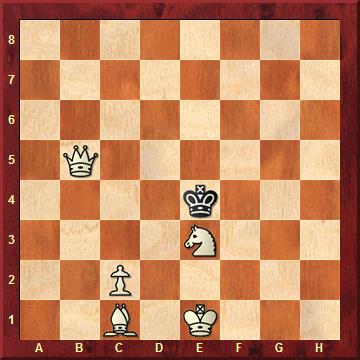December 30, 2015: Napoleon Running the Gauntlet
By Pál Benkö
A famous problem attracted my attention for examination and revision so as to enrich part of chess history that is connected to real history, specifically of Napoleon Bonaparte (1769-1821). All the more so since 2015 is the 200th anniversary of the remarkable Battle of Waterloo.
This well-known work of chess art was created by the best Russian player, theoretician and chess writer of that time, Alexander D. Petrov (1794-1867). The Petrov (Petroff) Defense was named after him, and he was also famous for constructing chess problems.

[Event "?"] [Site "?"] [Date "1824.??.??"] [Round "?"] [White "Petrov, A.D."] [Black "Mate in 14"] [Result "*"] [SetUp "1"] [FEN "3n4/2p3p1/4prB1/n1P5/p1pP1rp1/4b3/1pP1Np1K/1k3N1Q w - - 0 1"] [PlyCount "27"] [EventDate "1824.??.??"] [SourceDate "2015.12.21"] 1. Nd2+ Ka2 2. Nc3+ Ka3 3. Ndb1+ Kb4 4. Na2+ Kb5 5. Nbc3+ Ka6 6. Nb4+ ({Unfortunately the author overlooked}6. Qa8#) 6... Ka7 7. Nb5+ Kb8 8. Na6+ Kc8 9. Na7+ Kd7 10. Nb8+ Ke7 11. Nc8+ Kf8 12. Nd7+ Kg8 13. Ne7+ Kh8 14. Kg2# (14. Kg3#) *
Casting a first glance at the position we may find it rather chaotic, and it does not fit the historical story either. There are pieces that are not needed for the solution at all. Thus we can remove the bishop on e3, the rook on f4 and the pawn on g4, since they do not have any role in the battle. There are duals too, like either 5.Na3+ or 5.Nbc3+ being good, and at the end both 14.Kg2 and Kg3 deliver mate. All the above is forgivable, but unfortunately there is much shorter alternative solution (cook): 6.Qa8 mate, a deadly sin that ruins the value of the problem. The author obviously overlooked the problem of corners, but it does not touch the historical value of this work, and the role of Cossack Hussards in the process of chasing out Napoleon from Russia is witty and original.
Addendum: Garry Kasparov called to tell us that the move 6.Qa8 mate was not missed by Petrov, it reflected a general Russian theory at the time that the Russian army had failed capture Napoleon when it had been easily possible during the crossing of the river Berezina. The missed chance is symbolized by the 6.Qa8# "cook".

Napoleon's withdrawal from Russia: painting by Adolph Northen [source: Wiki]
There are more historical dates in my improvement below, so let me give a little historical reminder. The 18 pieces on the board symbolize that we are at the beginning of the 1800s. As tension with Alexander I, Emperor of Russia, grew, Napoleon expanded his Grande Armée to more than 450,000 men and, ignoring the advice against an invasion of the Russian heartland, launched an offensive campaign on 23 June 1812. The Russian Chief Commander Mikhail Kutuzov employed the tactic of putting off the final clash – he even gave up Moscow by evacuating it, but did not give up the battle. Faced with cold and hunger, and no hope for reinforcement, it was a difficult task to keep together such a huge French army. Therefore Napoleon had to order the retreat of his army, which turned into a disastrous escape. In the end just a fraction of the Grand Armée – 93,000 of the 690,000 men – returned alive. C. John Tarttelin writes:
The winter [of 1812] was the coldest in a 100 years. But what the retreating wraiths, shivering in their ragged uniforms, worried most about was the sudden appearance of the Cossacks. Only a few dark figures on horseback brandishing their fearsome lances was enough to spook a whole brigade – not that the shabby caricatures of soldiers struggling to survive in temperatures of minus 20 were now travelling in organized bands...

[Event "Version"] [Site "?"] [Date "2015.??.??"] [Round "?"] [White "Benko, Pal"] [Black "Mate in 15"] [Result "*"] [SetUp "1"] [FEN "3br3/2p3p1/1p3pP1/n7/p1nKB3/5R2/1pPNN3/k7 w - - 0 1"] [PlyCount "29"] [EventDate "2015.??.??"] [SourceDate "2015.12.21"] 1. Rf1+ Ka2 (1... b1=Q 2. Rxb1+ Ka2 3. Nc1+ Ka3 4. Kc3 Nb3 5. Nxc4#) 2. Nc3+ Ka3 3. Ndb1+ Kb4 4. Na2+ Kb5 5. Nbc3+ Ka6 6. Nb4+ Ka7 7. Nb5+ Kb8 8. Na6+ Kc8 9. Na7+ Kd7 10. Nb8+ Ke7 (10... Ke6 11. Bd5+ Ke7 12. Nc8+ Kf8 13. Nd7#) 11. Nc8+ Kf8 12. Nd7+ Kg8 13. Bd5+ Re6 14. Bxe6+ Kh8 15. Rh1# *

The Cossack Hussars attacking the Napoleonic army
The solution of the third problem is principally the same as for the second but it has been enriched by the switch-back of 1.Kh2+ and 15.Kg1 mate. The army of the Tsar is ready for counter-attack while the army of Napoleon is scattered during its retreat.
Pal Benko (version) 2015

White to play and mate in 15
We leave you to work out the mate in this most recent version by yourself.
After the problems shown above this should not cause any difficulty.
Benko's twins
The previous mate-in-two problem published on the 28th was the following:
Pal Benko, 2015

Mate in two moves – Solution: 1.Nf5 Kf3 2.Qe2#
The new twn problem is generated by inserting a white pawn on g2:
Pal Benko, 2015

Mate in two moves
One more twin: you must change the position, moving, inserting or removing a single piece, to get a mate in two problem with a different solution. Hint: with these twins the author has been aiming to construct a seasonal symbol for the final problem – as in his initial puzzle on December 25.





























